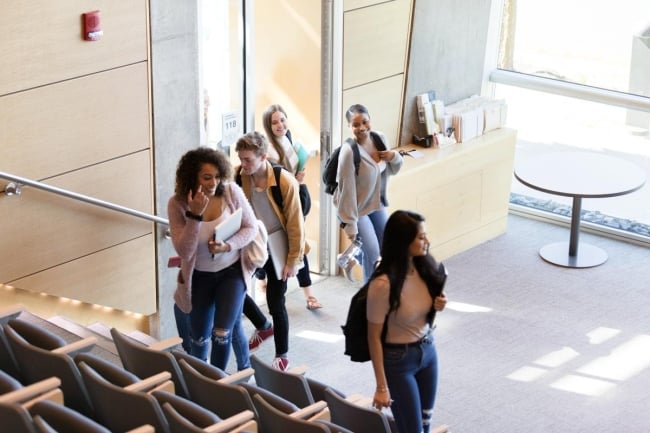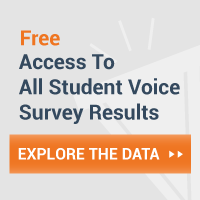You have /5 articles left.
Sign up for a free account or log in.

Getty E+ / SDI Productions
Establishing connections between students and faculty is a valuable part of the higher education experience, and it is more important than ever to encourage these connections. Today’s students are really looking for the opportunity to build relationships.
It’s interesting to think about the pre-pandemic students, and how, at the time, America’s colleges and universities were already at a place of very heightened awareness around the topics of anxiety and depression. And now, after the impact of the COVID-19 crisis, universities are welcoming students who didn’t go through rites of passage in high school, who didn’t have the in-person social relationships necessarily with friends or with their teachers, and who met with their coaches remotely.
 While we consider the differences between these students and those who came before them, it’s helpful to consider that we’re now looking at students who are ultimately going to be resilient because of what they’ve been through. But for now, as the world opens up to in-person opportunities again, college students place an even higher value on personal connections with faculty, staff and peers.
While we consider the differences between these students and those who came before them, it’s helpful to consider that we’re now looking at students who are ultimately going to be resilient because of what they’ve been through. But for now, as the world opens up to in-person opportunities again, college students place an even higher value on personal connections with faculty, staff and peers.
This has always been important. Looking back at my own college years, I can still tell you who my favorite professors were and whom I felt I had a connection with. Some of those connections lasted many years. I think smaller colleges where students can feel seen and feel valued are going to see more students seeking to establish these connections and may even begin to attract more students than larger institutions.
Connection Facilitation
What can faculty members do to help facilitate these connections since the students themselves may not initiate them?
They can plan formal activities such as placing an emphasis on students’ engagement in consistent office hours in person or virtually. They can invite students who are enrolled in their courses into their office hours for a particular purpose—not just stating that their “door is always open” and leaving the rest up to their students, but explaining how this time can be used and expressing an expectation or words of encouragement for students to see this as an opportunity to build a dialogue or to participate in a course-related activity. An example of such an activity might be reviewing a draft assignment.
Faculty should be aware of the importance of using their one-on-one time with students not just for registration but for advising. Questions faculty pose can intentionally move beyond determining what classes a student wants to take next semester and include broader questions:
- How are you doing?
- What did you do this weekend?
- What class are you enjoying the most?
- What are you thinking about for the future?
- Do you have a group of close friends?
- Do you feel like you’re in the right major?
- Is this semester going well for you?
Generative advising questions can help establish better connections.
I have seen faculty members very successfully set up casual, engaging activities with students in their program. They share ice cream, host potluck mixers, go on career-focused field trips, travel together as a small group to places related to class such as a museum and do service together supporting the broader community.
The pandemic and the move to virtual interactions made it difficult to do many of these activities. Many of us have a better sense of just how important these interactions are. They are valuable opportunities for connecting and being present outside the classroom.
From experience, it’s clear that students are very interested in working with faculty on research projects and in learning more about their research topics. In addition, just talking with students briefly at campus events, saying hello and catching up at football or soccer games, or seeing them at a campus concert, can be a great way to connect on a more personal level.
Students may be hesitant or too intimidated to approach faculty at public events like these, so faculty should consider taking the lead in breaking the ice, saying hello to a student, asking them about their day or if they’re enjoying the game.
Faculty Encouragement and Support
Quite often, colleges and universities can do a better job of encouraging and supporting those faculty members who want to facilitate these connections with students. We can notice and value their good efforts, allowing faculty to set goals around professional roles. And rather than thinking about making connections as something extra in the role of teacher and professor, it can be something that’s actually essential to the role.
I believe the faculty at Hartwick College or at many smaller colleges or universities would tell you that one of the best things about their job is the relationships that they build with the students.
At Hartwick, we developed an integrated, coordinated effort for developing strong connections with students.
Most colleges have some of the elements of FlightPath—our future-focused approach to education—in place, but not in the systematic, coordinated way that the Hartwick College community envisioned and implemented FlightPath. Hartwick has a four-year plan with opportunities to evaluate strengths, to explore majors and careers, to engage in service, to meet alumni, to publicly showcase their work, to design unique curriculum pathways, and to ultimately form a strong connection with Hartwick and its people.
Sometimes there are hurdles or roadblocks that need to be overcome when students and faculty seek to make these connections. We learned a few things about interaction during the pandemic with our changed modes of communication and course delivery. Pre-pandemic, I don’t think there was a norm to allow virtual meetings with students or to have faculty office hours opened up for virtual appointments. Faculty have told me they found strong participation in appointments when they were virtual.
A faculty member at Champlain College, my previous institution, shared with me that 100 percent of her advisees met during their appointment times for an entire day of virtual advising meetings. Having everyone participate as scheduled was a first in her more than 20 years of advising students.
It can be scary as a first-year student to go to a professor’s office for an appointment. The students want the connection, but they don’t necessarily initiate it. Virtual appointments are an easy, accessible entry point for students to engage with faculty, and I anticipate this mode of communication will continue beyond the pandemic.
[block:block=176]
At Hartwick, we also have a large percentage of students who are involved in additional activities such as athletics, music, art, theater and off-campus experiential learning opportunities—and their days are full. Allowing for virtual appointments is a door that opens another way to connect with their faculty. I believe we have learned that we can use virtual tools to connect rather than to disconnect, and I predict that Google Meets, Zoom and InSpace are here to stay.
“Are any of your professors currently choosing to teach virtually when the class was meant to be in person?” is a question asked in a recent Student Voice survey of 2,000 undergraduates, conducted by Inside Higher Ed and College Pulse with support from Kaplan. This is interesting because there’s something to be learned from some students who succeeded in the virtual environment and some faculty who excelled at teaching this way.
While there’s an undeniable quality to in-person interactions, we should not dismiss what we have learned from virtual interactions when the pandemic is finally over. We should anticipate an expanded interest in teaching and learning in online and hybrid formats. What did we learn, and what do we take forward with us from this experience? I look forward to these conversations with faculty.
Integral to FlightPath at Hartwick is the phrase “Every student, Every time.” That’s a lofty commitment, and it aligns well with what the Student Voice survey reveals about what students are looking for. It means our doors are open. It means we are using terms such as “intrusive advising.” It means any one of us who works with students intentionally initiates positive interactions. I have seen FlightPath moments in action and have felt proud to be a part of this initiative.
Models for Meeting Student Needs
While there are other effective programs designed to support students by fostering better connections between students and faculty on campuses large and small, they are often the exception rather than the rule. In the interest of better serving students, I believe higher education must meet the needs of today’s students.
Butler University in Indiana is doing just that, as it recently launched the Student Well-Being and Institutional Support Survey, the first national assessment to evaluate a campus’s impact on the well-being of its students. This includes assessing how they feel about the quality of interactions with other members of their campus community, including faculty.
Just because students may be hesitant to initiate a dialogue doesn’t mean they don’t want that interaction. It’s up to the colleges and universities, and to their faculty and staff, to take that first step.
Champlain College in Vermont, where I previously served as the dean of education and human studies, is also another college where the student is at the center of daily work for faculty and staff, and there are multiple programs where the focus is on supporting the individual. Currently, faculty in both the Stiller School of Business and Champlain College Online are focusing their advising efforts on appreciative advising to enhance the faculty/student relationship.
 In these examples, the solutions are based on the understanding that the student doesn’t always initiate contact with faculty, and that fact is also reflected in the Student Voice survey. Just because they may be hesitant to initiate a dialogue doesn’t mean they don’t want that interaction. It’s up to colleges and universities, and to faculty and staff, to take that first step.
In these examples, the solutions are based on the understanding that the student doesn’t always initiate contact with faculty, and that fact is also reflected in the Student Voice survey. Just because they may be hesitant to initiate a dialogue doesn’t mean they don’t want that interaction. It’s up to colleges and universities, and to faculty and staff, to take that first step.
Officials at all colleges and universities should be planning to improve these connections, thinking about the benefits of building programs of intrusive advising and mentoring, and how best to encourage faculty and staff to offer the invitation for interaction. The Student Voice survey reflects the need for more campuses to reach out and encourage better conversations and relationships to be built, and it raises two key questions: How are we opening those doors and how can we do a better job on behalf of our students’ learning and well-being?
Read more analysis of the Student Voice survey on perceptions of faculty, including coverage on how students want stronger connections with professors but rarely take the lead and on how students’ opinions of professors lean positive. Visit the Student Voice page this Friday for a visualization of how students view the impact of the pandemic on faculty.








